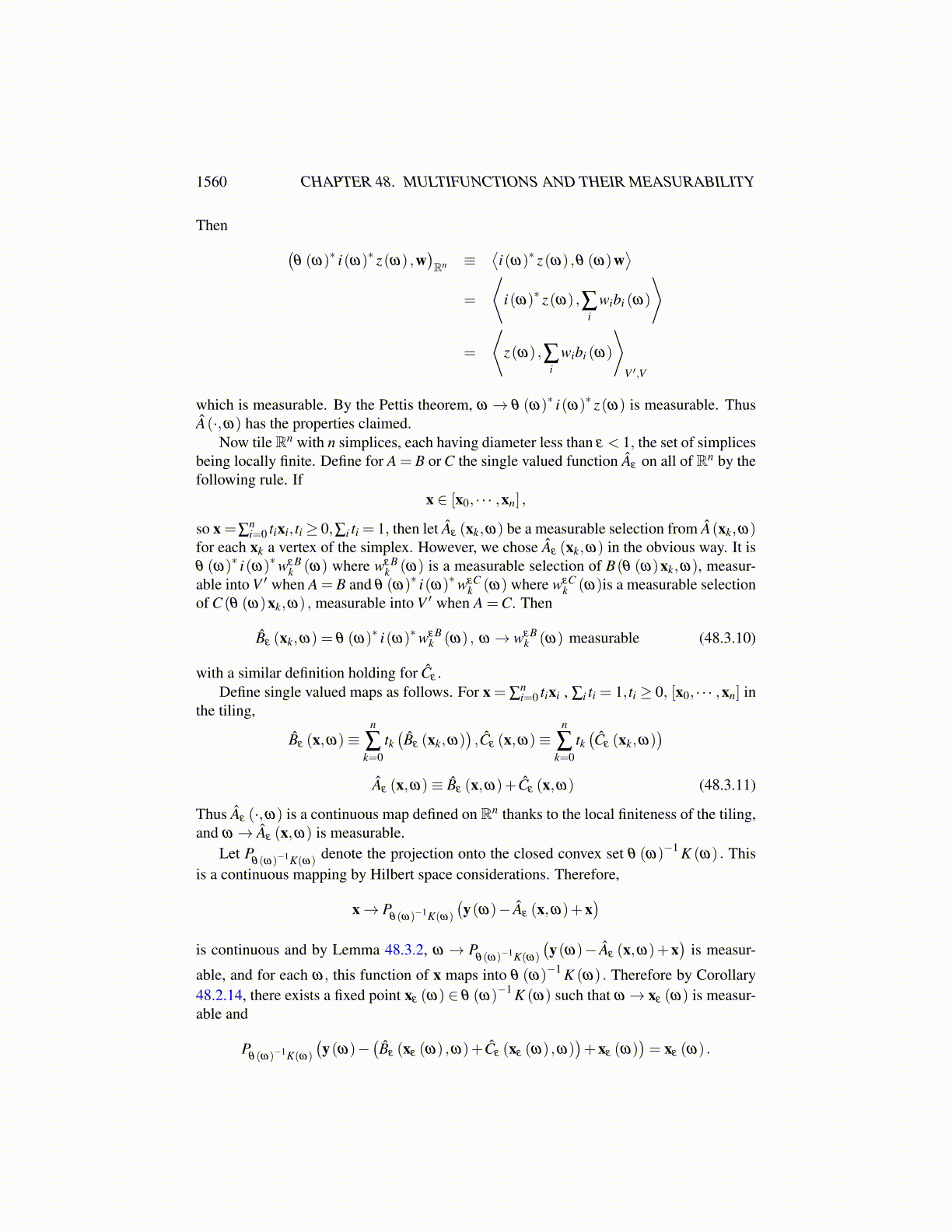
1560 CHAPTER 48. MULTIFUNCTIONS AND THEIR MEASURABILITY
Thus ∥u3 (ω)−u(ω)∥= d3. Continue this way, obtaining un (ω) such that
∥un (ω)−u(ω)∥= dn (ω)
and un (ω) ∈K (ω) with un measurable. Thus, in effect one picks the closest of all thewk (ω) for k ≤ n as the value of un (ω) and un is measurable and by density in K (ω) of{wn (ω)} for each ω,{un (ω)} must be a minimizing sequence for
λ (ω)≡ inf{∥u(ω)− z∥ : z ∈K (ω)}
Then it follows that un (ω)→ PK (ω)u(ω) weakly in Rn. Here is why: Suppose it fails toconverge to PK (ω)u(ω). Since it is minimizing, it is a bounded sequence. Thus there wouldbe a subsequence, still denoted as un (ω) which converges to some q(ω) ̸= PK (ω)u(ω).Then
λ (ω) = limn→∞∥u(ω)−un (ω)∥ ≥ ∥u(ω)−q(ω)∥
because convex and lower semicontinuous is weakly lower semicontinuous. But this im-plies q(ω) = PK (ω) (u(ω)) because the projection map is well defined thanks to strictconvexity of the norm used. This is a contradiction. Hence PK (ω)u(ω) = limn→∞ un (ω)and so is a measurable function. It follows that ω → PK (ω) (u(ω) ,ω) is measurable intoRn.
One way to prove the following Theorem in simpler cases is to use a measurable versionof the Kakutani fixed point theorem. It is done this way in [99] without the dependence onω . See also [35] for a measurable version of this fixed point theorem. However, one canalso prove it by a generalization of the proof Browder gave for a single valued case andthis is summarized here. We want to include the case where A is a sum of two set valuedoperators and this involves careful consideration of the details. Such a situation occurswhen one considers operators which are a sum, one dependent on the boundary of a region,and the other from a partial differential inclusion. Also, we will need to consider finitedimensional subspaces which depend on ω which further complicates the considerations.
Theorem 48.3.3 Assumtions: Let B(·,ω) : V →P (V ′) ,C (·,ω) : V →P (V ′) for V aseparable Banach space. Suppose that ω → B(x,ω) ,ω → C (x,ω) each has a measur-able selection and x→ B(x,ω) ,x→ C (x,ω) each is upper semicontinuous from strongto weak topologies. Also let E (ω) be an n dimensional subspace of V which has a basis{b1 (ω) , · · · ,bn (ω)} each of which is a measurable function into V, and that K (ω)⊆E (ω)where K (ω) is a measurable multifunction which has convex closed bounded values. Alsolet y(ω) be given, a measurable function into V ′. Conclusion: There exist measurable func-tions wB (ω) ,wC (ω) and x(ω) with wB (ω) ∈ B(x(ω) ,ω) ,wC (ω) ∈ C (x(ω) ,ω) , andx(ω) ∈ K (ω) such that for all z ∈ K (ω) ,
⟨y(ω)− (wB (ω)+wC (ω)) ,z− x(ω)⟩ ≤ 0
Proof: The argument will refer to the following commutative diagram.
E (ω)′θ(ω)∗→ Rn
i(ω)∗A(·,ω) ↑ ↑ θ (ω)∗ i(ω)∗A(θ (ω) ·,ω)
E (ω)θ(ω)← Rn